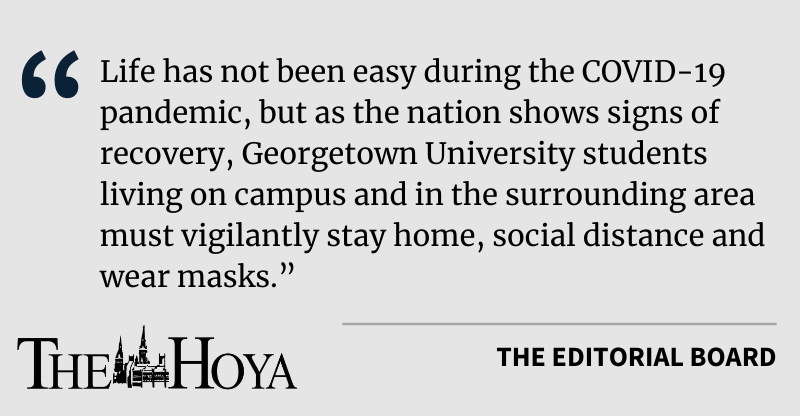Despite heightened hopes for a return to normal life during another difficult virtual semester, Georgetown University students must obey university health restrictions amid a rise in positive COVID-19 cases in the Georgetown community.
The increasing numbers of COVID-19 cases among students and faculty on campus and in the surrounding neighborhoods are dismaying. Almost 250 Georgetown community members have tested positive for the virus since Jan. 3, and 184 of those cases — mostly among students living in off-campus neighborhoods — occurred in the last two weeks. Life has not been easy during the COVID-19 pandemic, but as the nation shows signs of recovery, Georgetown students living on campus and in the surrounding area must vigilantly stay home, social distance and wear masks.
Certainly, there is reason to hope that the end of the pandemic is approaching. The current rate of new positive cases in America is less than half of its early January peak. Simultaneously, the nation is ramping up its distribution of vaccines to vulnerable populations, and more than 34 million Americans have received at least one dose of the COVID-19 immunization. At current rates, President Joe Biden predicts the United States will be able to fully vaccinate 300 million Americans by the end of this summer.
However, Georgetown students must not act recklessly while we wait for the vaccine to become available. New, more contagious variants of COVID-19 have arrived in the United States and are present in the Washington, D.C.-Maryland-Virginia area. The variants’ unmitigated spread, according to public health experts, could result in an explosion of new cases and deaths and undermine the protection that vaccines offer communities. Already, the B.1.1.7 COVID-19 variant, which is 35% more deadly than other variants, is doubling in infections every 10 days in the United States.
Amid new variants and an expected rise in cases, staying home and social distancing is imperative.
Among students on campus and in the surrounding neighborhoods, public health measures must be a top priority. The sheer number of cases on campus was disappointing, but worse was the high positive test rate of 1.33% — much higher than Georgetown Washington University, which has a positive test rate of just 0.26%.
Though many students are following COVID-19 safety guidelines, there are still students participating in large social gatherings, according to Mark Agard (SFS ’23), a Georgetown student living on campus.
“I’ll never know how many people are really staying in, but I choose to believe that the vast majority of us are, and I think that’s pretty accurate,” Agard wrote in an email to The Hoya. “I know I notice far too many students failing to respect regulations or hosting parties in spite of the danger, but to me ‘too many’ is any.”
Even with most students taking protective measures against COVID-19, case numbers are too high. We must do better as a community if we hope to go back to normal life in the foreseeable future.
A full return to campus depends on our ability to stay safe by following health and safety guidelines, according to a university spokesperson.
“COVID-19 presents health risks to everyone, including students living on campus, students living off campus, and people of all ages. We have seen this proven with the recent rise in positive COVID-19 cases among students on campus and in the neighborhood,” the spokesperson wrote in an email to The Hoya. “We will only be successful in fully returning to campus if we all work together to reduce the spread of the virus by wearing masks, keeping physical distance and avoiding indoor gatherings.”
These public health measures, including the move to a completely virtual environment for the academic year, have challenged everyone in the Georgetown community and have fallen particularly hard on first-year students. The urge to get together in person is a powerful one, especially after nearly a full year of virtual classes. But preventing the spread of the pandemic is paramount, and saving lives is an objective that outweighs any other interest students may have. We know the best ways to stay safe during this trying time; we need to stay vigilant about maintaining them.
Of course, maintaining a sense of community among the greater student body has been difficult without on-campus spaces. But keeping up with circles of friends is and will continue to be an important way of getting through the semester, according to Monica Essig-Aberg (COL ’22), who is currently living in the Burleith neighborhood.
“I remain involved in certain student organizations,” Essig-Aberg said in a phone interview with The Hoya. “I’m happy that I still have a network of people in D.C. that I can hopefully see once cases subside. I stay connected with Georgetown friends virtually still via FaceTime and social media.”
Though the pandemic and virtual learning environment have been difficult for everyone, students must be cautious and rely on each other as a community to stay healthy long enough to get a vaccine. Until then, we absolutely must continue obeying official and university orders to prevent the spread of COVID-19.
The Hoya’s Editorial Board is composed of six students and is chaired by the opinion editor. Editorials reflect only the beliefs of a majority of the board and are not representative of The Hoya or any individual member of the board.










Victoria C. • Feb 12, 2021 at 2:08 pm
Isn’t it interesting that GW has such a low positivity rate despite having double the number of students living on campus? Georgetown should have allowed a similar 2,000 number to live in the campus bubble rather than force them to the neighborhoods, which is especially dangerous for First Years living on their own for the first time.